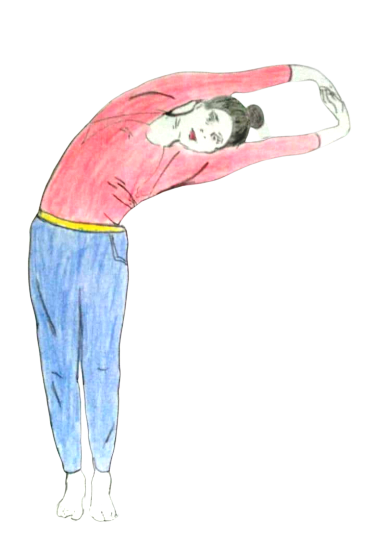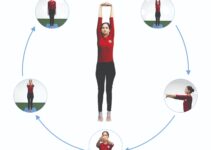Hastottanasana meaning

Hastottanasana consists of two words: Hasta means ‘Arms’, and Uttana means ‘Stretched up’. Hastottanasana is named so because this standing yoga pose stretches the arms upwards, followed by side bending. That’s why it is also known as the Up-stretched arms yoga asana. Here, the easy steps of doing hastottanasana have been described. Being a standing side pose, it has so many benefits for the toes and head; especially, it is helpful in case of kidney diseases and constipation. Here, we will mention its steps, easy procedure, health benefits, precautions and contraindications.
How to do hastottanasana step by step
Here are five simple and easy ways of doing this yoga pose. Following these techniques, anyone can practice them at home.
Step 1
- Stand in Tadasana
Step 2
- Inhale and raise arms over the head. Interlock the fingers.
Step3
- Exhaling, bend to the left side from the waist.
Step4
- Maintain the position as long as you can. Come back to Tadasana.
Step5
- Do this 2-3 times or at your convenience.
10 best health benefits of hastottanasana
- Yoga for height: This is an effective yoga pose to increase height as it gives suitable stretch from toes to fingers. Therefore, it should be practised by those who desire to increase their size.
- Back pain: It stretches the muscles appropriately, especially the finer back muscles. The regular practice of this yoga pose relieves back discomfort.
- Spinal health: It is beneficial for spinal health. After focusing on the alignment of the body and spine, it helps to improve the curvature of the spine.
- Weight loss: It is known as yoga for waist slim, yoga to remove fats from hips and buttocks due to adequate stretch in these regions.
- Asthma control: It provides stretch to the chest region, thus helping to increase the intake capacity of the lungs. All these ensure the betterment of lung health and relieve asthma.
- Constipation relief: It ensures proper movement to the alimentary canal, especially the stomach, intestine, and large intestines, relieving constipation.
- Abdominal sides’ fat: This is one of the best yoga poses to burn the fat from the abdominal sides because of experiencing extra stretching in these areas.
- Nerves health: Regular yoga poses facilitate stretching from toes to fingers. If it is maintained with breathing, it can show its impact on the efficiency of nerves.
- Strengthening of legs: The asana is good for the health of toes, feet, ankles, knees, buttocks, etc.
- Sciatica: Sciatica pain can be reduced drastically if practised under a yoga expert’s supervision.
Hastottanasana precautions
Some of the contradictions of hastottanasana are given below:
- Pregnancy: The asana should be avoided during pregnancy.
- Leg pain: The patient suffering from leg pain should skip performing the yoga pose.
- Dizziness: In case of dizziness, it should not be performed.
- Varicose vein: A person suffering from varicose veins should take the help of a yoga expert.
- Headache: Don’t perform during headache.
- Insomnia: A yoga therapist should be consulted before practising the yoga pose.
Hastottanasana beginner’s tip
Though, it’s an easy yogasana to practice. However, to get perfection in the yoga pose, it requires practice and concentration. Initially, it is not easy to stand erect with feet together; therefore, it has a distance between your feet and gradually minimises the distance. Those who practice it for the first time can take the support of the wall. Do it for a few seconds and gradually increase the pose’s duration.
Preparatory pose of hastottanasana (Yoga should be done before hastottanasana )
- Tadasana
- Stickasana
- Katichakrasana
- Trikonasana
Follow up pose of hastottanasana (Yoga should be done after hastottanasana)
- Padmasana
- Vipritkarni
- Padhastasana
- Sarvangasana
- Sirsasana





